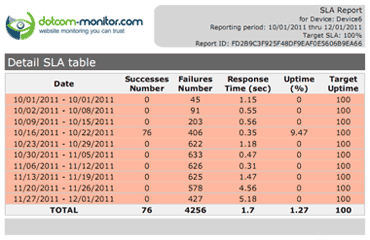In the past five years the number of externally hosted elements on the webpages of the top 1,000 websites has more than doubled, according to a report by WebsiteOptimization. Moreover, as the number of third-party hosts associated with websites continues to increase, Service Level Agreements (SLA) attached to those third-party hosted elements have also increased in importance.
Determining the performance of third-party hosted applications and webpage elements can be a challenge. The reason is those third-party hosted elements are impacted by network conditions, page conditions and server issues. In order to provide effective SLA management information, a performance monitoring solution needs to take all of these factors – the network, webpage, and server – into account. As SLA management directly impacts the revenues and business relations between two companies, the quality of the monitoring tool must be high.
What do we mean by high quality monitoring?
Below are two distinctions of “high-quality monitoring” to to look for when employing monitoring as part of SLA management strategy:
- Non-cached DNS: For example, an external monitoring service that can measure network, page, and server issues must do so without “caching” domain name server (DNS) records. If DNS records are cached by the monitoring service then DNS issues at the third-party vendor will be missed by the monitoring service.
- Consistent monitoring locations: Some services use a “staggered method” of monitoring whereby agent servers are provisioned based on monitoring agent server capacity. An algorithm is then used to average the timing of monitoring. Conversely, a “high-quality” monitoring service needs to provide a consistent method where agent servers are available for consistent monitoring (they should have enough capacity to monitor in a consistent manner) in order to provide accurate data for SLA management.
Using Web Monitoring Tools for SLA Management
When used for SLA management, performance monitoring has both reactive and proactive goals. Here are three examples of it’s use:
- When used to react to SLA parameters, a monitoring solution focuses on uncovering errors related to performance and uptime.
- The SLA monitoring additionally provides the validation needed to prove an SLA is being met.
- And finally, uptime monitoring provides proactive information that can be used for determining charge-backs, parties responsible for service outages, and so forth.

For the customers of service providers who are relying on SLAs, the purpose of monitoring focuses on validating deliverables. In other words, customers need to make sure a service provider is meeting the SLA expectations outlined. Other critical elements delivered by SLA monitoring include error forensics capabilities, which can be used to determine if and when SLA have failed to meet expectations. A monitoring service should also deliver detailed reports on usage and availability that can be used to determine return on investment (ROI) and total cost of ownership (TCO) when it comes to using these third-party services. For further samples, see the Dotcom-Monitor Wiki article on SLA reports.
Find more on Dotcom-Monitor SLA Management here.
{ photo credit: ganderssen1 – cc }

